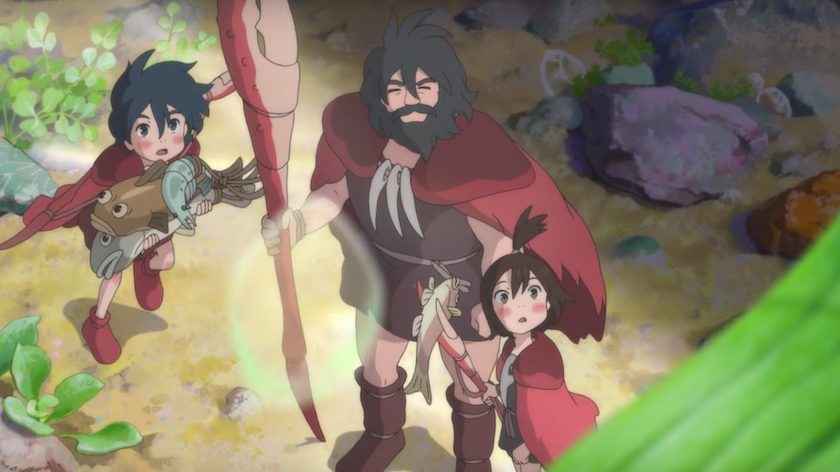Anthology films – feature-length movies composed of individual segments and stories, usually with a different director for each segment – are typically a pretty big risk for any studio, whether it’s live-action or animation. The format promotes unbridled creativity, allowing filmmakers to let their imaginations soar, ignoring the basic 120-minute flow and structure of a typical theatrical film, telling the stories and articulating the themes and concepts that mean the most to them.
That format doesn’t typically lead to massive financial success, however – anthology films can be a pretty challenging sell, and without a singular hook to hang your marketing campaign on, it can be a real uphill climb to attract a wide audience. Which makes it extra fascinating that Studio Ponoc – the freshly-minted team of ex-Studio Ghibli artists who came together after Ghibli’s production department largely shuttered in 2014 – decided to follow up their splashy, visually arresting 2017 fantasy Mary and The Witch’s Flower with an anthology film, Modest Heroes: Ponoc Short Films Theater Vol. 1, which is in theaters now.
The film features three segments, each with a different vision – there’s Kanini & Kanino, directed by academy award nominee Hiromasu Yonebayashi (who helmed Mary and The Witch’s Flower, along with When Marnie Was There and The Secret World of Arrietty during his days at Ghibli) about a couple of crab siblings navigating the frightening and perilous natural world. Life Ain’t Gonna Lose is the product of Yoshiyuki Momose, animation director behind Ni no Kuni: Wrath of the White Witch and pupil of Ghibli legend Isao Takahata, which follows a young boy confronting a food allergy with dramatic results. Finally, Ghibli key animator Akihiko Yamashita offers his directorial debut in Invisible, about a man whose life begins to literally drift away from him – and it’s up to him to bring himself back to a full-throated existence.
After a successful debut like Mary and The Witch’s Flower, why an anthology for Studio Ponoc? In an interview with Anime News Network, Modest Heroes producer and Studio Ponoc founder Yoshiaki Nishimura explains their approach:
NISHIMURA: “At Studio Ghibli, as I completed my work as the producer of The Tale of the Princess Kaguya, which took over eight years, Studio Ghibli announced that it would close its production department right after the release of its next film, When Marnie Was There, which I also produced. I established Studio Ponoc immediately after that closure, and released Mary and The Witch’s Flower less than two and a half years later.
During that time Director Hiromasa Yonebayashi and the artists and other staff who joined Studio Ponoc devoted all of their time, passion and energy to making one single film. In truth, after the establishment of the Studio and production and release of Mary, all of us were completely worn down and exhausted.
Deep down all of us at Ponoc, including the three directors of the short films Hiromasa Yonebayashi, Yoshiyuki Momose, and Akihiko Yamashita, and myself, share a deep and strong will to create new films. But at the same time we felt a gap between our will and the conditions surrounding us. Studio Ponoc draws every piece of animation – every frame of animation and every background painting – in hope of creating valuable animated films that will make children smile and audiences happy. But as we approached completion of Mary, the physical toll we all suffered made us look at our work through a more objective eye.
These days films are created in many places and the number of animated works as well as live-action films just keeps growing. Now we have new distribution channels, streaming services and film productions around the world creating more films than ever. Simply put, the world is full of films.
This being the case, I strongly believed we needed a different perspective when creating new animated films and films in general. But we didn’t know how to proceed. We came to a halt. And that’s precisely and fortunately when the plan to develop animated short films emerged. The initial idea was to create a spin-off of Mary for promotional use. But I didn’t have confidence at that point that I could create a valuable and meaningful spin-off with limited production time. Then I considered the idea of dividing a 30-minute story into four animated shorts, each seven-and-a-half minutes long.
What do we need to look forward in making our next animated film and to continue making more? My answer is that we should believe in what we develop and create, and take the next steps to present our animation with pride to children and adults.
Just as Takahata and Miyazaki constantly believed in the richness of animation, we needed to establish a new foundation to rediscover the richness of animation ourselves. We decided to pursue this challenge by creating animated short films.”
